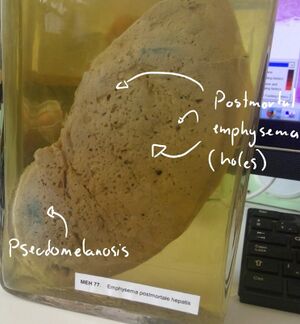1. Postmortem emphysema of the liver: Difference between revisions
(Created page with "'''Organ:''' Liver '''Description:''' The liver appears to have several "holes". Pseudomelanosis can also be seen on the preparation. Pseudomelanosis is a green discoloration that can be found in certain organs, most commonly the gastrointestinal tract and the liver surface, but also in the skin and on the surface of the spleen. It’s caused by the same H2S gas that causes liver emphysema. This gas reacts with the iron atom in haemoglobin, which forms a compound calle...") |
No edit summary Tags: Manual revert Visual edit |
| (2 intermediate revisions by the same user not shown) | |
(No difference)
| |
Latest revision as of 13:53, 21 June 2024
Organ: Liver
Description:
The liver appears to have several "holes". Pseudomelanosis can also be seen on the preparation. Pseudomelanosis is a green discoloration that can be found in certain organs, most commonly the gastrointestinal tract and the liver surface, but also in the skin and on the surface of the spleen. It’s caused by the same H2S gas that causes liver emphysema. This gas reacts with the iron atom in haemoglobin, which forms a compound called sulfmethaemoglobin.
Diagnosis: Postmortem emphysema of the liver
Causes:
- The air around the cadaver must be moist and the temperature between 23 and 45°C.
Theory:
During the heterolysis, the bacteria in the bowels produce gases like CO2, CO and importantly H2S (hydrogen sulphide). These gases can get into the portal vein from the gastrointestinal tract. The portal vein leads these gases to the liver, where the gases makes “bubbles” in the (otherwise solid, non-holey) liver. This causes the “swiss-cheese” look of the liver. This is an emphysema, a term that describes abnormal presence of gases in organs and tissues.
For postmortal emphysema to occur, the air around the cadaver must be moist and the temperature between 23 and 45°C.
Postmortal emphysema of the liver needs to be distinguished from polycystic liver disease. In the latter case the holes would be bigger, and there would be fibrosis present as well.

